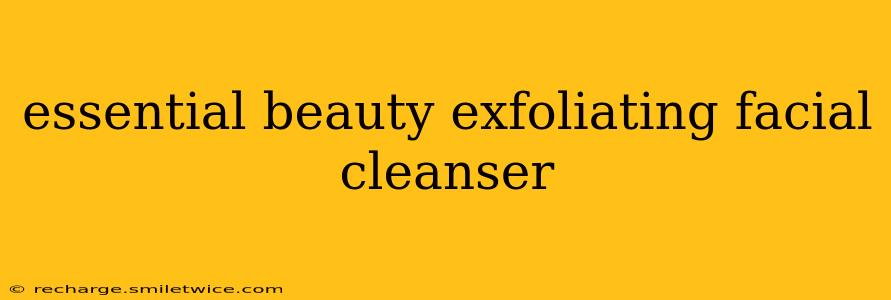Exfoliating facial cleansers are a cornerstone of any effective skincare routine. They gently remove dead skin cells, revealing brighter, smoother skin underneath. But with so many options available, choosing the right exfoliating cleanser can feel overwhelming. This guide will help you understand the benefits, types, and how to choose the best exfoliating facial cleanser for your skin type.
What is an Exfoliating Facial Cleanser?
An exfoliating facial cleanser is a specialized cleanser that contains ingredients designed to remove dead skin cells from the surface of your skin. Unlike regular cleansers that primarily focus on removing dirt and oil, exfoliating cleansers go a step further to promote cell turnover, leading to a variety of skin benefits.
What are the Benefits of Using an Exfoliating Facial Cleanser?
Regular use of an exfoliating facial cleanser offers numerous benefits for your complexion:
- Brighter Skin: By removing dead skin cells, exfoliation reveals the brighter, more radiant skin underneath.
- Smoother Skin Texture: Exfoliation helps to smooth out rough patches and uneven skin tone.
- Improved Product Absorption: Removing dead skin cells allows your serums and moisturizers to penetrate more effectively, maximizing their benefits.
- Reduced Appearance of Acne: Exfoliation can help to prevent clogged pores, reducing the likelihood of breakouts.
- Minimized Appearance of Fine Lines and Wrinkles: While not a miracle cure, regular exfoliation can help to improve skin texture and reduce the appearance of fine lines and wrinkles.
What are the Different Types of Exfoliating Facial Cleansers?
Exfoliating cleansers primarily fall into two categories:
-
Physical Exfoliants: These contain small particles, such as beads or grains, that physically scrub away dead skin cells. Examples include those containing crushed walnut shells, apricot kernels, or jojoba beads. Caution: Harsh physical exfoliants can cause micro-tears in the skin if used too aggressively, so choose gentle options and avoid harsh scrubbing.
-
Chemical Exfoliants: These use chemical compounds to dissolve the bonds between dead skin cells, allowing them to be easily rinsed away. Common chemical exfoliants include AHAs (alpha-hydroxy acids) like glycolic acid and lactic acid, and BHAs (beta-hydroxy acids) like salicylic acid. These are generally gentler than physical exfoliants but can still cause irritation if used incorrectly.
What are AHAs and BHAs?
AHAs (Alpha Hydroxy Acids): These are water-soluble acids that exfoliate the skin's surface. They are excellent for improving skin texture, reducing fine lines, and brightening the complexion. Glycolic acid is a popular AHA known for its effectiveness. Lactic acid is gentler and often preferred for sensitive skin.
BHAs (Beta Hydroxy Acids): These are oil-soluble acids that penetrate pores to exfoliate and unclog them. Salicylic acid is the most common BHA and is particularly effective for treating acne-prone skin.
How Often Should I Use an Exfoliating Facial Cleanser?
The frequency of use depends on your skin type and the strength of the exfoliant. Generally:
- Sensitive Skin: Use 1-2 times per week, or even less frequently.
- Normal Skin: Use 2-3 times per week.
- Oily Skin: You might be able to use it more frequently, but always listen to your skin and adjust accordingly.
Always start with less frequent use and gradually increase the frequency as your skin tolerates it. If you experience irritation, redness, or burning, immediately reduce the frequency or discontinue use.
What are the potential side effects of using an exfoliating facial cleanser?
While generally safe, exfoliating cleansers can cause side effects if misused:
- Irritation and Redness: This is common, especially with stronger exfoliants or if used too frequently.
- Dryness: Over-exfoliation can strip the skin of its natural oils, leading to dryness and tightness.
- Sun Sensitivity: Some exfoliants can increase your skin's sensitivity to the sun, so always use sunscreen after exfoliating.
How to Choose the Right Exfoliating Facial Cleanser?
Consider these factors when choosing an exfoliating cleanser:
- Skin Type: Choose a cleanser formulated for your specific skin type (oily, dry, sensitive, combination).
- Exfoliant Type: Decide whether you prefer a physical or chemical exfoliant, considering your skin's sensitivity.
- Ingredients: Look for ingredients that address your specific skin concerns (e.g., acne, hyperpigmentation, dullness).
- Reviews: Read reviews from other users to get an idea of the product's effectiveness and potential side effects.
By carefully considering your skin type and needs, you can find the perfect exfoliating facial cleanser to help you achieve radiant, healthy skin. Remember to always patch test a new product before applying it to your entire face.
